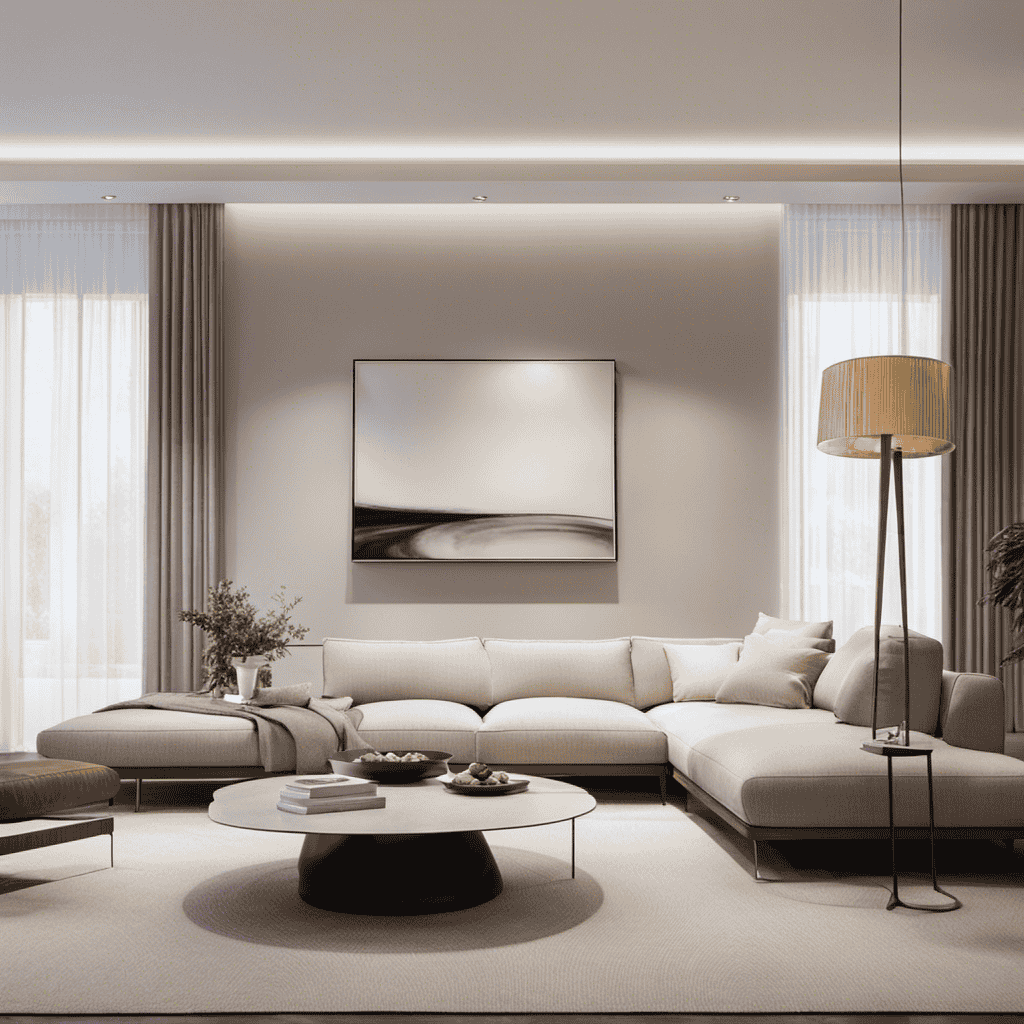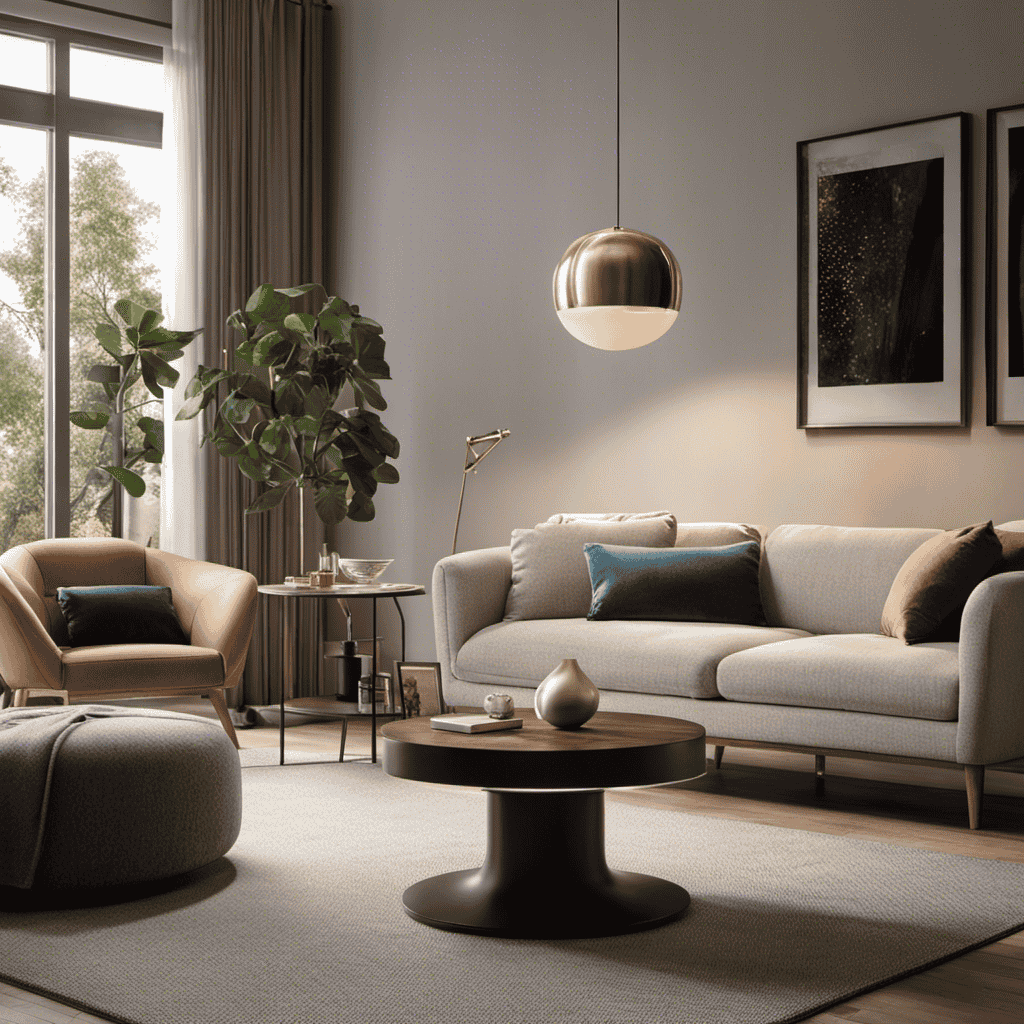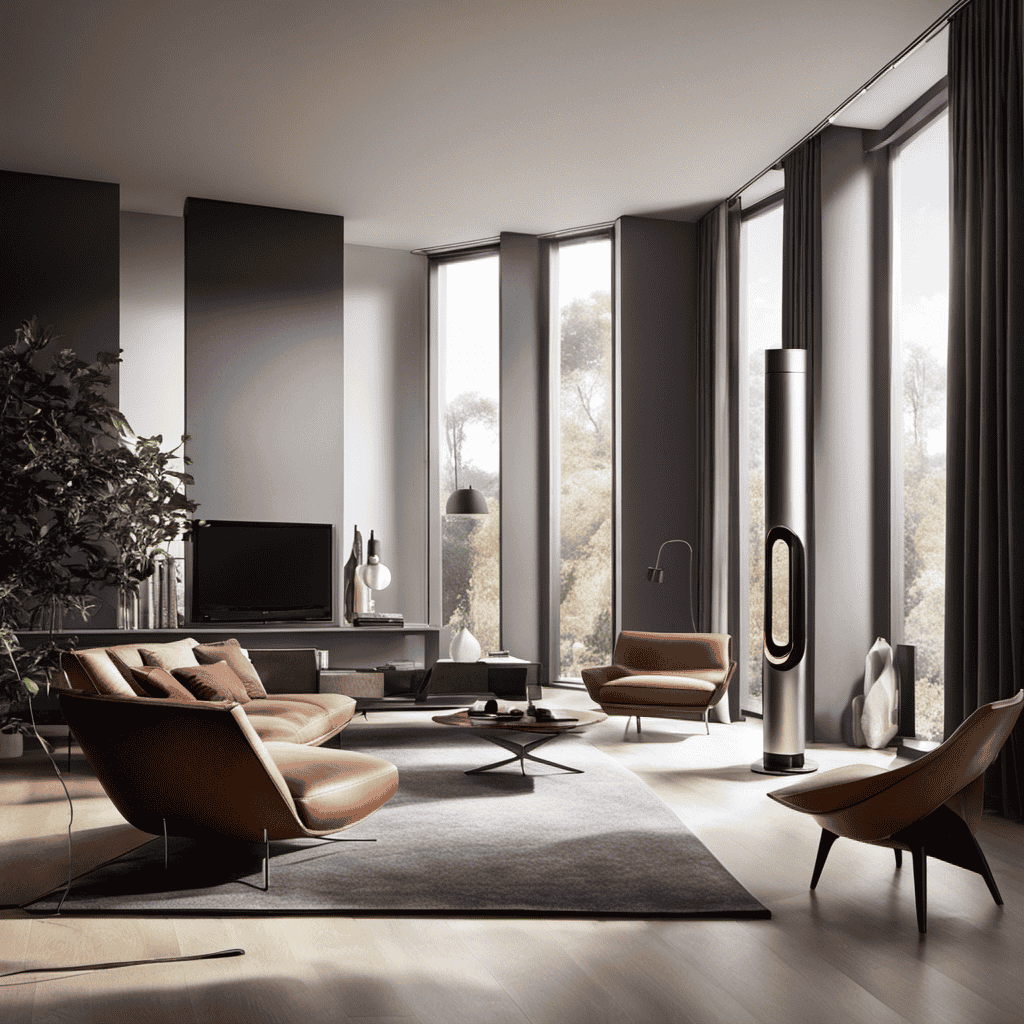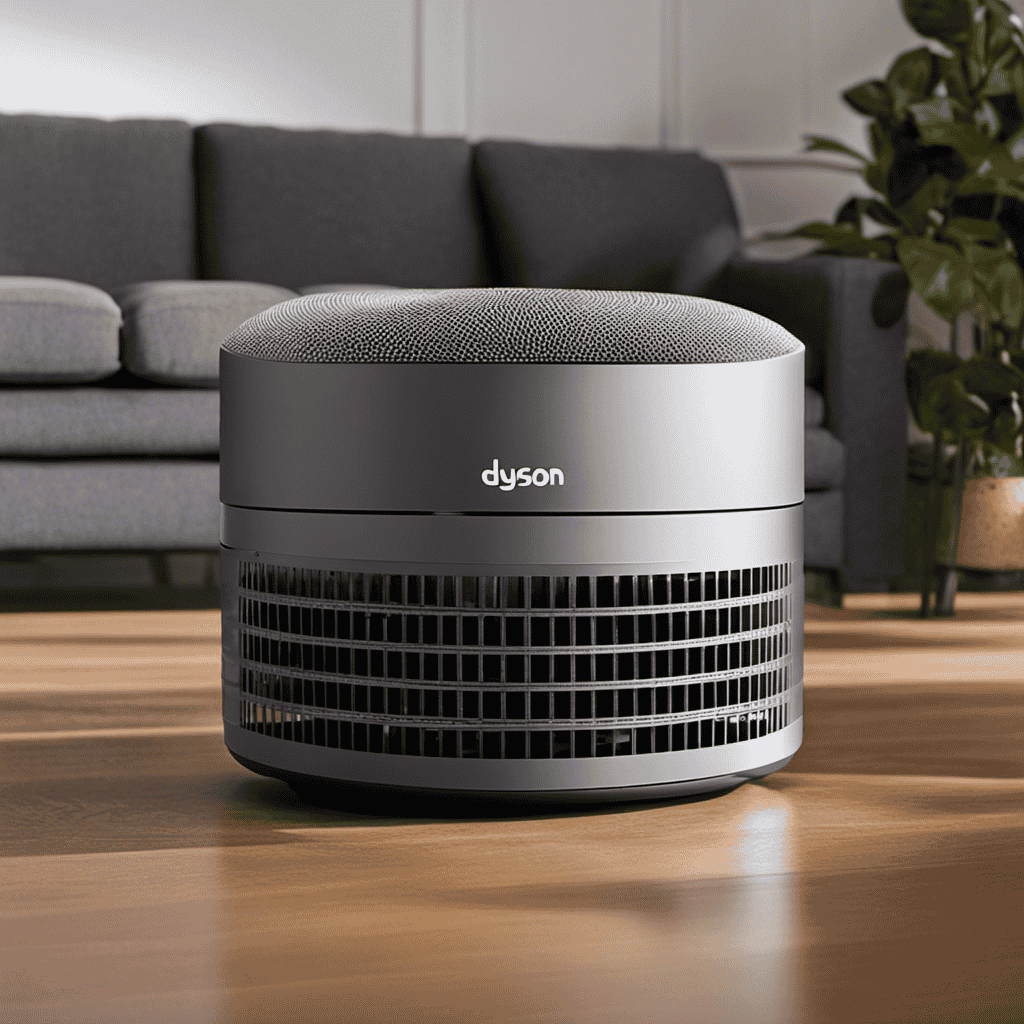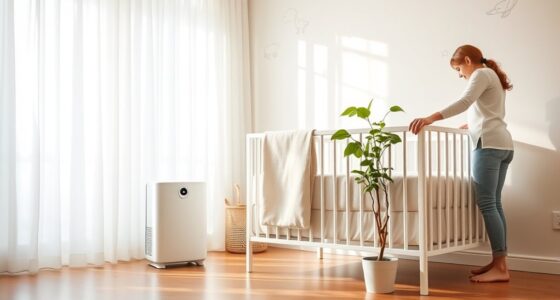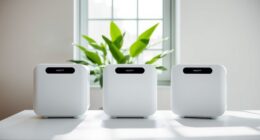The old saying goes, ‘Clean air, clear mind.’ Determining the optimal runtime for an air purifier is essential for maintaining a healthier indoor environment.
In this article, I will explore the factors to consider when deciding how long to run your air purifier. From room size and pollutant levels to optimizing efficiency and adjusting for allergen triggers, I’ll provide evidence-based tips to help you make the most of your air purifier’s runtime.
Let’s dive in and breathe easier together.
Key Takeaways
- The recommended duration for operating an air purifier is at least a few hours a day for optimal results.
- Highly polluted areas may require continuous air purifier usage.
- Regularly clean or replace filters to maintain optimal performance.
- The capacity of an air purifier depends on the size of the room, and larger rooms require higher air purifier capacity for effective air cleaning.
Factors to Consider in Determining Air Purifier Usage Time
When determining how long to use an air purifier, there are several factors to consider.
The recommended air purifier usage depends on various factors that influence its runtime.
Firstly, the size of the room plays a crucial role. Larger rooms may require longer operating hours to effectively clean the air.
Additionally, the level of air pollution in the area is another important factor. If you live in a highly polluted area, it is recommended to run the air purifier for longer periods to ensure continuous purification.
Furthermore, the specific needs of individuals, such as allergies or respiratory conditions, should be taken into account.
These factors collectively determine the optimal duration for operating an air purifier, ensuring clean and healthy air quality in your living space.
In the subsequent section, we will discuss the recommended duration for using an air purifier.
Recommended Duration for Operating an Air Purifier
For optimal results, it’s best to run the air purifier for a recommended duration. There are several factors to consider when determining how long to use an air purifier.
The size of the room, the level of pollutants, and the strength of the air purifier are all important considerations. In general, it is recommended to run the air purifier for at least a few hours a day to effectively remove airborne contaminants. However, if the room is highly polluted or if you have allergies or respiratory issues, it may be beneficial to run the air purifier continuously.
Additionally, remember to clean or replace the filters regularly to maintain optimal performance. By considering these factors and following these tips, you can ensure optimal usage of your air purifier.
Understanding the Relationship Between Room Size and Purifier Runtime
To effectively clean the air in a room, it’s important to consider the size of the room and how long the purifier needs to run.
The capacity of an air purifier refers to its ability to clean a specific volume of air within a given time frame. The larger the room, the higher the air purifier capacity required to effectively clean the air.
Similarly, the purifier runtime effectiveness is determined by the duration the purifier operates. It is crucial to ensure that the air purifier runs for an adequate amount of time to sufficiently remove pollutants from the air.
By understanding the relationship between room size and purifier runtime, we can ensure that we achieve optimal air cleaning results.
Now, let’s explore how pollutant levels influence the length of air purifier usage.
How Pollutant Levels Influence Air Purifier Usage Length
If pollutant levels are high, it’s important to run the purifier for a longer duration in order to effectively clean the air. High pollutant levels can be harmful to our health, causing respiratory issues and allergies. To ensure a healthy indoor environment, it is crucial to maintain pollutant levels within acceptable limits. Air quality standards set by organizations like the Environmental Protection Agency (EPA) provide guidelines on safe pollutant levels.
Tips for Optimizing Air Purifier Efficiency and Runtime
When it comes to air purifiers, finding the ideal runtime and maximizing efficiency are crucial factors to consider.
It’s important to understand how long the air purifier should be turned on to effectively remove pollutants from the air without wasting energy.
Additionally, there are various tips and strategies that can help optimize the efficiency of an air purifier, ensuring that it operates at its highest potential and provides clean, fresh air for longer periods of time.
Ideal Air Purifier Runtime
The ideal runtime for an air purifier is typically determined by the size of the room and the air quality. To ensure optimal performance and efficiency, it is important to follow proper air purifier maintenance and consider the benefits of continuous air purification. Here is a table that provides a general guideline for the ideal runtime based on room size:
| Room Size | Ideal Runtime |
|---|---|
| Small | 4-6 hours |
| Medium | 6-8 hours |
| Large | 8-10 hours |
| Extra Large | 10-12 hours |
| Open Space | 12+ hours |
It’s important to note that these are just general recommendations and may vary depending on individual needs and air quality. By using your air purifier consistently and following proper maintenance, you can enjoy the benefits of continuous air purification. Now let’s explore some tips for maximizing air purifier efficiency.
Maximizing Air Purifier Efficiency
To get the most out of your air purifier, make sure to regularly clean or replace the filters. Factors to consider when optimizing your air purifier’s efficiency include the size of the room, the level of air pollution, and the sensitivity of the occupants to allergens.
A larger room may require a longer runtime to effectively clean the air, while a heavily polluted environment may warrant a higher fan speed. It’s also important to note that running the air purifier continuously may not be necessary if you are using it in a relatively clean environment.
To save energy and prolong the lifespan of the unit, consider using a timer or sensor-based feature that adjusts the operation time based on air quality. By considering these factors and implementing these optimization tips, you can enhance the effectiveness of your air purifier while saving energy.
Understanding the impact of indoor and outdoor air quality on purifier operation time is crucial for making informed decisions about when and how long to run your air purifier.
The Impact of Indoor and Outdoor Air Quality on Purifier Operation Time
You should consider the impact of indoor and outdoor air quality on how long you should keep your air purifier turned on. The quality of the air we breathe has a direct impact on our health, and air pollution can have serious consequences. Using an air purifier can help mitigate the effects of air pollution and improve indoor air quality. Here are some key points to consider:
- Indoor air quality: Factors like cooking fumes, dust, pet dander, and volatile organic compounds (VOCs) can affect the air quality inside our homes.
- Outdoor air quality: Pollutants such as smoke, smog, and pollen can enter our homes and decrease indoor air quality.
Using an air purifier regularly can help remove these pollutants and provide several benefits, including reducing the risk of respiratory diseases, improving sleep quality, and alleviating allergy symptoms.
Transition: Now that we understand the impact of air quality on air purifier usage, let’s explore how to adjust its usage based on specific allergen and asthma triggers.
Adjusting Air Purifier Usage Based on Allergen and Asthma Triggers
Now that we’ve covered the impact of air quality, let’s see how we can adjust our air purifier usage based on allergen and asthma triggers.
Adjusting air purifier settings and monitoring air quality are crucial in maintaining a clean and healthy environment. When allergens are high, such as during pollen season, it is recommended to increase the fan speed of the air purifier to effectively capture and remove these particles from the air.
Additionally, for individuals with asthma, it is beneficial to use air purifiers with HEPA filters to trap and remove asthma triggers such as dust mites and pet dander.
By regularly monitoring indoor air quality and adjusting the air purifier settings accordingly, we can create a safer and more comfortable living space.
Transitioning into the subsequent section, let’s now delve into determining the ideal daily and nightly air purifier operating hours.
Determining the Ideal Daily and Nightly Air Purifier Operating Hours
When it comes to air purifiers, finding the optimal purifying duration is crucial. It’s important to strike a balance between efficiency and effectiveness.
In this discussion, we will explore how to determine the ideal daily and nightly operating hours for air purifiers, taking into consideration factors such as room size, air quality, and specific needs.
Optimal Purifying Duration
The optimal duration for running an air purifier is typically between 4 to 8 hours per day. This range ensures efficient air purification without excessive energy consumption.
Factors to consider when determining the specific duration include the size of the room, level of air pollution, and the sensitivity of individuals to airborne contaminants.
To optimize the purifying duration, here are some tips:
-
Consider the air quality in your area. If you live in a highly polluted region, you may need to run the air purifier for longer periods.
-
Set the air purifier to run during times when indoor air pollution is likely to be highest, such as during cooking or cleaning activities.
-
Use a timer to schedule the purifier to run for a specific duration each day.
-
Monitor the air quality using a sensor to determine if adjustments to the purifier’s duration are necessary.
Balancing Efficiency and Effectiveness
To balance efficiency and effectiveness, it’s important to find the optimal duration for running your purifier. Balancing energy consumption while ensuring clean air is crucial. Finding the right air purifier can help achieve this balance. Consider factors such as room size, air quality, and filter type.
| Room Size | Air Quality | Filter Type |
|---|---|---|
| Small | Moderate to Good | HEPA |
| Medium | Moderate to Poor | Activated Carbon |
| Large | Poor | Electrostatic |
For small rooms with moderate to good air quality, a HEPA filter is sufficient. In medium-sized rooms with moderate to poor air quality, an activated carbon filter is recommended. For large rooms with poor air quality, an electrostatic filter is ideal. By selecting the right filter for your specific needs, you can optimize the duration of running your purifier, effectively balancing energy consumption while ensuring clean air for your space.
What is the recommended duration for using an air purifier?
The recommended air purifier operation time varies depending on the model and the size of the room. Generally, it is suggested to run an air purifier for 8-12 hours a day for optimal results. This duration allows the purifier to effectively clean and maintain the air quality in the space.
Frequently Asked Questions
Can I Leave My Air Purifier on All the Time?
Yes, you can leave your air purifier on all the time. It continuously filters out pollutants, improving air quality. However, consider the energy consumption. Set a schedule or use a smart feature to optimize usage.
How Often Should I Clean or Replace the Filters in My Air Purifier?
I clean or replace my air purifier filters every three months. It’s recommended to clean them at least once a month. Regular maintenance ensures optimal performance and helps remove particles like dust, pollen, and pet dander.
Does the Location of the Air Purifier in the Room Affect Its Efficiency?
The location of the air purifier in the room can affect its efficiency. Factors like room size and air circulation impact its performance. Placing it in a central location with good airflow is ideal.
Is It Safe to Use an Air Purifier in a Room With a Newborn Baby or Young Children?
It’s safe to use an air purifier in a room with a newborn or young children. Air purifiers can provide numerous benefits, including improved air quality and reduced exposure to allergens and pollutants. They are effective at removing harmful particles from the air.
Can an Air Purifier Help Eliminate Cooking Odors or Pet Odors in the House?
Yes, an air purifier can help eliminate cooking odors and pet odors in the house. It works by filtering out the particles and odors in the air. I’ve noticed a significant improvement in air quality since using mine.
Conclusion
In conclusion, determining the appropriate duration for operating an air purifier depends on various factors. These factors include room size, pollutant levels, and individual needs. It’s important to optimize the efficiency and runtime of the purifier. This can be done by following tips such as keeping windows closed and regularly cleaning the filters.
Just like a diligent gardener tends to their plants, we should tend to our air purifiers. This will ensure clean and fresh air in our homes.
